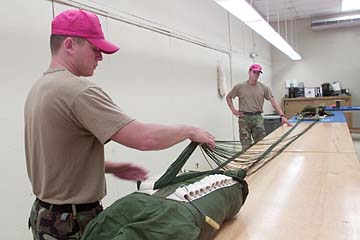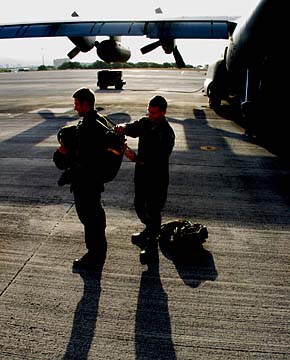


|
After nearly 20 years of flying Army Staff Sgt. Mario Sanchez still gets those butterflies and that uneasy feeling during the first few moments of flight. Jumps keep
paratroopers
fit for flightBy Gregg K. Kakesako
gkakesako@starbulletin.comBut it's hard to reconcile that admission as he regularly crouches at the edge of the open back end of a C-130 Hercules Air Force Reserve cargo plane some 1,000 feet above Schofield Barracks preparing Army and Marine paratroopers for their qualification jumps.
Cruising along at about 130 knots on four turboprop engines, the C-130 is one of two belonging to the 910th Air Wing, an Air Force Reserve unit from Youngstown, Ohio, which was recently in the islands for a two-week training mission.
It is Sanchez's job as safety jump master for the 25th Infantry Division to ensure that the parachute jumps end without a mishap.

|
On this day the C-130 left Hickam Air Force Base with one Marine and five soldiers who were working to maintain their jump status. The flight would take 40 minutes.By 7:55 a.m. the C-130 air crew had gotten permission to take off from Hickam and made its way along the Leeward Oahu coastline.
At 8:10 a.m. the cargo plane lumbers over Kaena Point, turns to Dillingham Air Field and headed for Wheeler Army Air Field and the adjacent designated drop zone.
Six minutes before reaching the drop zone Sgt. 1st Class Edward Flores orders the jumpers sitting on the starboard side of the aircraft to go through their check list. A few minutes later, he tells them to stand up and to hook up the static lines from their parachutes to the wire that runs the length of the cargo department. When the jumpers leave the aircraft they will fall a set distance before the static yanks open the chute.
At 8:15 a.m. the clam-shell like end of the C-130 opens revealing the pineapple carpeted landscape of Leeward Oahu. Peering over the edge of the cargo ramp without a tether lifeline and with only a chute on his back, Sanchez looks for familiar landmarks.
"A soon as I see Wheeler tower," he said, "I know we are one minute from the drop zone. Then there's a bridge which we means we're 30 seconds away."

|
Sanchez is also looking for orange panels and a few vehicles that will mark the mile-long drop zone. The signal light above the jumpers blinks from bright red to green and the jumpers are ordered to "go."Five bodies shuffle out that back and seconds later five olive green nylon chutes bellow out below.
By 8:35 a.m. the C-130 is back at Hickam.
Chief Warrant Officer Ricky Kimberlin, commander of the 87th Quartermaster Detachment (Parachute), said there has never been a fatality involving military jumpers in the islands although there might have been a few hard landings.
"We always thinking safety," said Sanchez who has been on jump status since 1994 and has served as a black hat instructor at the Army's airborne school at Fort Benning, Ga.
The same safety first maxim rules the nine-member parachute rigger command under Kimberlin that works out of former aircraft hanger and office space at Hickam Air Force Base.
"Even the packed parachutes have to be kept under lock behind at least three doors," he said.
Kimberlin, who also served as an instructor at the Army's parachute rigging school, added: "Safety is our most important thing here. Each rigger has to sign each chute that he packs."
Sanchez said that the Army works closely with the Hawaii Air National Guard's 204th Air Lift Squadron and schedules weekly parachute drops every Tuesday night.

|
Flores, supervisor in the 25th Division's air operations sections, said that an individual soldier needs to jump "once every three months to keep his qualifications current and keep up his proficiency."Recently, Flores, a 13-year veteran who also participated in the 1989 Panama invasion, led a contingent of six Army soldiers and one Marine who jumped into a Schofield Barracks drop zone to maintain their qualification.
Each soldier was equipped with a MC1-1 olive-colored rip-stop nylon parachute which has a circular canopy or shroud that expands to 35 feet in diameter. Heavier drop cargo chutes range in diameter from 68 inches to 120 feet and can support loads up to 12,000 pounds.
Depending on the mission, Sgt. 1st Class Roy Emerson, another Panama veteran, added a soldier could be carrying as much another 100 pounds in equipment.
His rifle is generally stored in a specially developed padded gun case attached to the left side of the soldier. Other equipment is connected by a harness to the soldier and dangles 15 feet below him with the soldier required to cut it loose before both of them hit the ground.
An average qualification jump is short; lasting anywhere from 10 to 15 seconds after the paratrooper leaves the aircraft at 1,000 feet.
Once the jumpers return to Hickam each of the chutes are opened and hung and shaken out to remove any debris.
"If we catch a hole, we tag it," Kimberlin said, "and we send it to maintenance."
The 87th Quartermaster Detachment-- which began as a railroad company -- is equipped with various sewing machines with needles wide and strong enough to penetrate plywood. It's wartime mission is provide 1,000 personnel parachutes during a 45-day period.
These days as the only parachute riggers in the islands the Army unit supports not only soldiers and the Special Operations Command at Camp Smith, but also Marines, the Air Force and the Hawaii Army and Air National Guard.